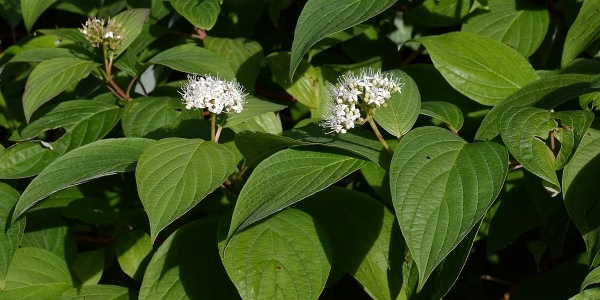
Dogwood (Shrub Dogwoods)
Botanical Name
:
Cornus spp.
Plant Type
:
Deciduous shrub
Seasons
:
Plant in early spring (after last frost) or early fall; blooms in late spring to early summer
Sun Level
:
Full sun to partial shade; thrives in at least 6 hous of direct sunlight per day
Ideal Soil Temperature for Planting
:
60–70°F (15–21°C)
Soil Type
:
Moist, well-drained soil; tolerates a wide range of soil types including clay
Hardiness Zones
:
2–9 (USDA)
Germination
:
A few weeks to several months, depending on species
P.H. Level
:
5.0–7.0 (acidic to neutral)
Water/Irrigation
:
Keep soil consistently moist but not waterlogged, especially during dry periods. Mulch to retain moisture
Fertilization
:
Use a balanced fertilizer (e.g., 10-10-10) in early spring
Habit
:
Multi-stemmed, spreading shrub with arching branches
Propagation
:
By seed, softwood cuttings in early summer, or hardwood cuttings in late fall or early winter
Final Plant Height
:
3–15 ft, depending on the species
Spread
:
6–12 ft
Flowers
:
Small, creamy white flowers in flat-topped clusters
Attracts
:
Bees and butterflies
Uses
:
Ornamental, erosion control, wildlife habitat, hedges, and borders
Companions
:
Viburnums, ferns, ornamental grasses, and other moisture-loving plants
Pruning
:
Prune in late winter or early spring to remove dead or damaged wood and to maintain shape
Toxicity
:
Non-toxic to humans and pets
Pests
:
Leaf miners, scale insects, borers, and aphids
Diseases
:
Anthracnose, powdery mildew, leaf spot, and canker
Fun Fact
:
Dogwoods are known for their distinctive bark and bright red or yellow stems in winter. The name “Dogwood” is derived from “dagwood,” as the hard wood was historically used to make “dags” (daggers, skewers)
Botanical Name
:
Cornus spp.
Plant Type
:
Deciduous shrub
Seasons
:
Plant in early spring (after last frost) or early fall; blooms in late spring to early summer
Sun Level
:
Full sun to partial shade; thrives in at least 6 hous of direct sunlight per day
Ideal Soil Temperature for Planting
:
60–70°F (15–21°C)
Soil Type
:
Moist, well-drained soil; tolerates a wide range of soil types including clay
Hardiness Zones
:
2–9 (USDA)
Germination
:
A few weeks to several months, depending on species
P.H. Level
:
5.0–7.0 (acidic to neutral)
Water/Irrigation
:
Keep soil consistently moist but not waterlogged, especially during dry periods. Mulch to retain moisture
Fertilization
:
Use a balanced fertilizer (e.g., 10-10-10) in early spring
Habit
:
Multi-stemmed, spreading shrub with arching branches
Propagation
:
By seed, softwood cuttings in early summer, or hardwood cuttings in late fall or early winter
Final Plant Height
:
3–15 ft, depending on the species
Spread
:
6–12 ft
Flowers
:
Small, creamy white flowers in flat-topped clusters
Attracts
:
Bees and butterflies
Uses
:
Ornamental, erosion control, wildlife habitat, hedges, and borders
Companions
:
Viburnums, ferns, ornamental grasses, and other moisture-loving plants
Pruning
:
Prune in late winter or early spring to remove dead or damaged wood and to maintain shape
Toxicity
:
Non-toxic to humans and pets
Pests
:
Leaf miners, scale insects, borers, and aphids
Diseases
:
Anthracnose, powdery mildew, leaf spot, and canker
Fun Fact
:
Dogwoods are known for their distinctive bark and bright red or yellow stems in winter. The name “Dogwood” is derived from “dagwood,” as the hard wood was historically used to make “dags” (daggers, skewers)
Written by Nondiah Khalayi – https://www.linkedin.com/in/nondiah-khalayi/

